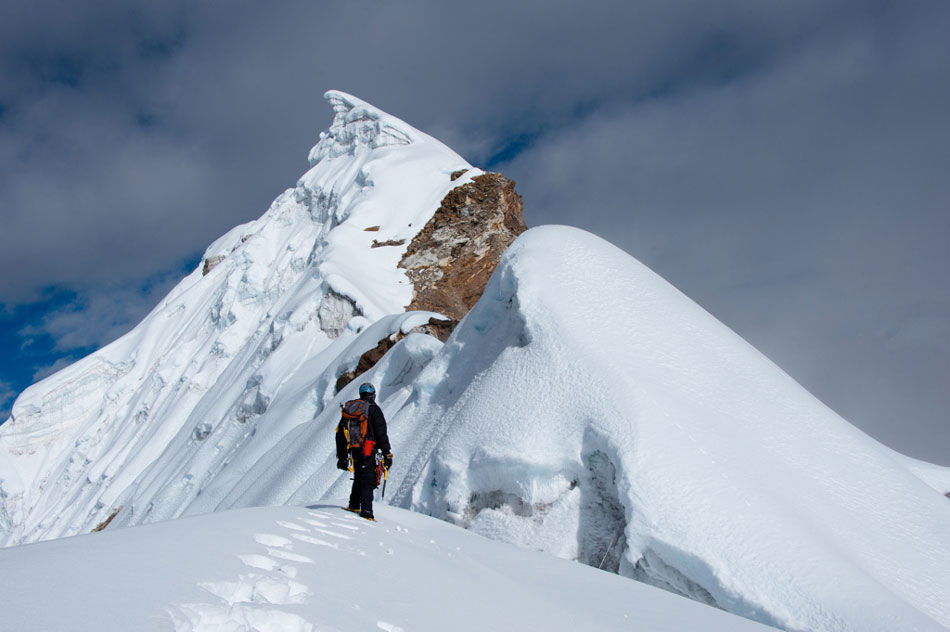Lobuche Peak Climbing Cost: Itinerary and Tips for a Successful Summit
Trip Overview
Have you ever dreamed of standing on top of a Himalayan peak, surrounded by snow-capped giants and endless skies? Lobuche Peak offers just that—without needing to be a professional mountaineer. Nestled in the heart of the Khumbu region near Everest, Lobuche Peak (6,119 meters) is a stunning, achievable adventure for trekkers seeking a bit more thrill than a standard trek.
What does the itinerary look like? How much will it cost? What gear do you need? Don’t worry—we’ve got you covered. This guide is your one-stop resource for Lobuche peak climbing with itinerary and cost.
What is Lobuche Peak?
Lobuche Peak is a magnificent trekking peak situated near the Khumbu Glacier, not far from Everest Base Camp. It actually has two summits—Lobuche East (6,119m) and Lobuche West (6,145m). Most climbers go for Lobuche East, which is considered more accessible and does not require technical climbing.
Think of Lobuche as a perfect stepping stone for those aiming to try their hand at mountaineering without diving into full-scale expeditions like Everest.
Why Choose Lobuche Peak Over Others?
You might wonder, “Why not Island Peak or Mera Peak?” Good question!
Proximity to Everest Base Camp: Many combine EBC with Lobuche, killing two birds with one stone.
Stunning Views: From the summit, enjoy jaw-dropping vistas of Everest, Lhotse, Nuptse, and more.
Less Crowded: Compared to Island Peak, Lobuche sees fewer climbers—ideal for a peaceful ascent.
Good Training Ground: A great peak if you’re planning higher climbs in the future.
Climbing Lobuche is like learning to swim in a deep pool before heading into the open sea—challenging yet manageable.
How Difficult is Lobuche Peak Climbing?
Let’s be real—Lobuche is no walk in the park. But it’s not Everest either.
Technicality: Minimal. You’ll use ropes, harnesses, and crampons but don’t need to be a pro.
Altitude: The real challenge is the height. Altitude sickness can hit if not acclimatized well.
Physical Fitness: You should be in good shape. If you can hike 6-7 hours a day with a backpack, you’re on the right track.
It’s like hiking on a steep, icy staircase—with crampons and a breathtaking view to keep you going.
Best Time to Climb Lobuche Peak
Timing is everything when it comes to Himalayan adventures.
Spring (March to May): Clear skies, warmer temperatures, blooming rhododendrons.
Autumn (September to November): Stable weather, crystal-clear views.
Winter & Monsoon: Avoid due to heavy snow or rains and unpredictable conditions.
Pro Tip: Spring and autumn are also peak times for Everest, so the trails might be lively (but not crowded on the summit route).
Detailed Itinerary: Day-by-Day Plan
Here’s a standard 18-day itinerary combining EBC and Lobuche East summit:
| Day | Activity |
| 1 | Arrival in Kathmandu, Nepal. |
| 2 | Fly to Lukla, Trek to Phakding. |
| 3 | Trek to Namche Bazaar. |
| 4 | Acclimatization Day in Namche. |
| 5 | Trek to Tengboche. |
| 6 | Trek to Dingboche. |
| 7 | Acclimatization Hike in Dingboche. |
| 8 | Trek to Lobuche. |
| 9 | Trek to Gorakshep, Visit Everest Base Camp. |
| 10 | Climb Kala Patthar, back to Lobuche. |
| 11 | Trek to Lobuche High Camp. |
| 12 | Summit Day (Lobuche East), back to High Camp. |
| 13 | Trek to Pangboche. |
| 14 | Trek to Namche. |
| 15 | Trek to Lukla. |
| 16 | Fly back to Kathmandu. |
| 17 | Buffer day. |
| 18 | Departure from Kathmandu, Nepal. |
You can shorten this if you skip EBC, but trust us—it’s worth the visit.
Lobuche Peak Climbing Cost 2025/2026
| IN THE AUTUMN SEASON (OCT, NOV) | USD 2050 Per Person |
| IN THE SPRING SEASON (APR, MAY) | USD 2175 Per Person |
Note: We also organize only LOBUCHE PEAK CLIMBING. If you want the itinerary of only Lobuche Peak Climbing and its cost, please contact us.
The above Package Cost includes:
• On your arrival day, airport pickup service by car.
• 3-night accommodation in Kathmandu at Tourist Standard Hotel with breakfast (1 night before the trek and 1 night after the trek).
• Air Tickets for Lukla Flights.
• Airport tax on Lukla flights.
• 12-night accommodation in Mountain Lodge/ Tea House during trekking.
• 2-night accommodation in a tented camp.
• 3 Meals (breakfast, lunch, and dinner) in a day during the trek and climbing.
• One experienced trek Guide and climbing Sherpa for climbing.
• Porter for the entire trekking. (As a practice, the porter will be provided based on one porter sharing by two trekkers. According to the rule, one porter carries the luggage of two trekkers with a total maximum weight limit of 25 kg).
• Expenses for food, accommodation, insurance, transport, and the wages of trekking staff.
• Trekking Permit (TIMS Card)/ Khumbu Gaun Palika fee.
• Sagarmatha National Park fee.
• Lobuche Peak climbing permit fee.
• Climbing equipment like ice axe, Ice crew, snow bar, Ice Hammer, and climbing rope.
• Camping gear like two men’s tent, kitchen tent, kitchen equipment, and mattress while climbing period.
• All ground transport types as mentioned in the itinerary.
• Altitude medicines, Oximeter, first aid medicines.
• Map of the Trekking route.
• Trip Achievement Certificate (If you need it).
• Duffel Bag to keep your trekking stuff.
• All government taxes, local taxes, and tourist service charges.
• On your departure day, airport drop service by car.
The above Package Cost does not include the following:
• Airfare for your international flight.
• Nepal Visa Fee.
• Your travel insurance which includes high-altitude helicopter evacuation and medical (It is advised the insurance should cover high-altitude emergency rescue, evacuation & medical.).
• Alcoholic beverages, any hot and cold drinks, hot water, bottled water, and dessert.
• Personal trekking and climbing gear (Climbing boot, Sleeping bag, down Jacket, etc.). You can rent them in Kathmandu and Dingboche/ Lobuche.
• All kinds of personal expenses like phone calls, internet use, laundry, battery charge, hot- shower during trekking, excess baggage charge on Lukla flight, etc.
• Lunch and dinner in Kathmandu, except for farewell dinner on the last night of the trip.
• In case of emergency helicopter rescue/ evacuation & its cost.
• Tips for Trekking Staff.
• Any expenses arising from natural calamities, mishaps, personal sickness, flight cancellation, political strikes, or anything beyond our control (Costs are not refundable and non-transferable if you leave the trek and climbing voluntarily and want to return from the trek earlier than scheduled).
• Cost of any extra services, if you use, which are not mentioned in the above package, includes section.
Note:
• The above price is on a per-person basis for a minimum group size of 2 people. We also organize Solo Everest Base Camp Island Peak Summit climbing. For the solo trip, a single supplement charge will be applied. Please contact us for the price of the Solo Trip.
What Gear Do You Need for Lobuche?
Here’s what you’ll need for the climb:
Technical Gear: Crampons, harness, ice axe, helmet, ropes (often provided by agencies)
Clothing: Layered jackets, thermal base layers, down jacket, gloves, warm socks
Footwear: Mountaineering boots (Insulated, B2/B3)
Sleeping Bag: Rated for -15°C to -20°C
Others: Sunglasses, headlamp, trekking poles, sunscreen, water bottles
You can rent gear in Kathmandu or Dingboche or Lobuche if you’re not a regular climber.
Safety Tips for a Successful Summit
Acclimatize properly: Take your time.
Hydrate: 3–4 liters/day.
Know AMS symptoms: Headache, nausea, dizziness.
Weather Check: Conditions can change fast.
Follow your guide’s lead.
Altitude Sickness – What to Know
Altitude sickness doesn’t care how fit you are. Even athletes suffer.
AMS (Acute Mountain Sickness): Most common.
HACE & HAPE: Severe and life-threatening.
Preventative: Go slow, hydrate, consider Diamox (ask your doctor).
Listen to your body—it whispers before it screams.
How to Train for Lobuche Peak?
Cardio: Running, cycling, stair climbing.
Strength Training: Focus on legs and core.
Hiking Practice: Do long treks with a loaded backpack.
Mental Prep: Climbing is as much mental as physical.
Train like you’re preparing for a high-altitude marathon.
Environmental and Cultural Etiquette
Pack Out Trash: Leave no trace.
Respect Locals: Greet with “Namaste,” dress modestly.
No Bargaining in Teahouses: Prices are fair, given the remoteness.
Stay on Trails: Avoid damaging flora/fauna.
Final Thoughts and Recommendations
Lobuche Peak climbing with itinerary and cost in mind is an adventure of a lifetime. It’s not just about reaching the top—it’s about the journey, the people you meet, and the stories you’ll carry forever.
So, whether you’re a thrill-seeker or a dreamer standing at the crossroads of courage and curiosity—Lobuche awaits you.
Frequently Asked Questions (FAQs)
1. Is Lobuche Peak harder than Island Peak?
Lobuche is slightly more technical, especially the final section before the summit, but both require similar fitness levels and preparation.
2. Can beginners climb Lobuche Peak?
Yes, with proper training and a guide, beginners with good trekking experience can successfully summit.
3. How long does it take to climb Lobuche Peak?
It usually takes about 18 days, including acclimatization and Everest Base Camp trekking.
4. Do I need travel insurance for Lobuche climbing?
Absolutely. Make sure it covers high-altitude trekking and emergency helicopter evacuation.
5. What happens if I get sick during the climb?
Guides are trained to handle AMS. If needed, helicopter evacuation can be arranged from key points on the route






